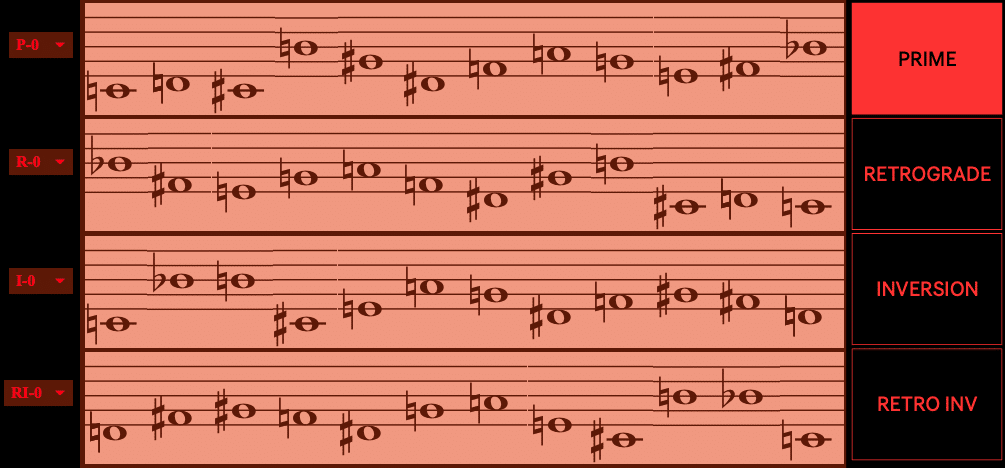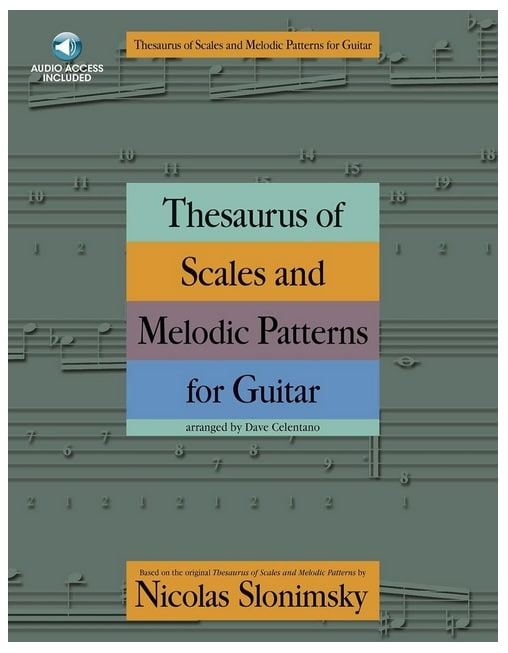12-tone music also known as dodecaphony is a method of organizing pitches and harmony often attributed to Austrian composer, Arnold Schoenberg (although another Austrian composer, Joseph Matthias Hauer, proposed similar ideas a few years earlier). It was a controversial technique that sought to eliminate the idea of a tonic, the mainstay of traditional diatonic harmony. This article will explore the history and basic techniques of the 12-tone method for pitch organization and its potential uses in all genres of music. I’ll provide some examples and direction for producers and instrumentalists who want to dig deeper. Don’t be put off by all the theory at the beginning of this article–if you read on you’ll find some useful ideas applicable to your music regardless of genre.
THE SOUND
The sound produced with 12-tone writing is atonal, meaning without a tonal center or key. It seemed a natural progression from the highly chromatic writing of late Romanticism and Expressionism. Below is a classic Schoenberg work from 1909 that demonstrates atonality and is a precursor for the twelve-tone system he later developed.
Five Pieces for Orchestra by Arnold Schoenberg
One of the first 12-tone pieces is considered to be Schoenberg’s, Suite for Piano, Op.25
The 12-tone system was initially shunned by composers like Igor Stravinsky, who later embraced the method and applied it to some degree in works like Agon and Movements for Piano and Orchestra (source). Other notable composers that used the 12-tone method and variations include Alban Berg, Anton Webern, Pierre Boulez, and Karlheinz Stockhausen to name a few.
Total Serialism, was a more extreme off-shoot of dodecaphony that involves serializing all elements of music including rhythm, duration, dynamics, and articulation. This approach and other variants were developed and used by composers such as Milton Babbitt, Pierre Boulez, and Karlheinz Stockhausen. Babbitt’s, Three Compositions for Piano “… is regarded as one of the first pieces, if not the first piece, to exhibit serial techniques that go beyond the confines of the twelve-tone row” (source).
Three Compositions for Piano by Milton Babbitt
To appreciate 12-tone music requires a suspension of typical tonal-based expectations. The intervallic space between adjacent notes in the row becomes a defining factor in the overall sound as the work unfolds. The 12-tone method flourished in academia and concert halls for decades but ultimately suffered a backlash as composers, and particularly minimalists in the 60’s, sought to bring back some notion of tonality to contemporary music. But the dissonant and unsettling nature of the 12-tone music is particularly well-suited for film scoring and the aesthetic can be heard in numerous commercial contexts.
THE METHOD
The method starts by writing a row of 12 tones from the chromatic scale so that no notes are repeated until all have been used. The underlying premise is that no particular note takes precedence or has more importance than any other note, as would be the case in tonal harmony. This row forms the basis of how notes can be used the work. From the original row, referred to as the Prime row, three other variations can be created by reversing the order of the row and inverting intervals. Below is an example of a 12-tone row and and its three variants. Note that all notes have been constrained to the octave above middle C, but octave displacement can be used freely in the writing process.
- Prime (P)
- Retrograde (R) (Prime in reverse order)
- Inversion (I) (Prime with inverted intervals)
- Retrograde Inversion (RI) (Inversion in reverse order)
Once the three main variants are determined they can be transposed to begin on any of the 12 chromatic notes bringing the total number of variations to 48 (= 4 x 12). These transposed variations are indicated with numbers after the row used such as: P0, P1, P2 or Ro ,R1, R2, etc.
PITCH CLASSES AND THE MATRIX
Pitch class is a means of identifying certain notes by an integer, regardless of octave. In the typical case, fixed zero is used so that 0 always represents the note C. You might also see moveable zero analyses where the theorist chooses which note to designate as 0. But the numerical relationships remain proportional so that the intervallic distance between 0 to 3 and 6 to 9 is the same–in this case a minor 3rd.
In fixed-zero terminology the notes:
C C# D D# E F F# G G# A A# B = 0 1 2 3 4 5 6 7 8 9 10 11
(sometimes t and e are used to represent 10 and 11)
Below is an example of a 12-Tone Matrix with all possible iterations. A matrix can be used for atonal harmonic analysis or for quickly access content related to the Prime row in the compositional process. I used the incredibly useful Matrix generator found at musictheory.net in which you enter the notes of the Prime row and it generates the other 3 variants and all the transposed versions.
Generated by the Matrix Calculator
SET THEORY
Other ideas that are used in twelve-tone writing include juxtaposing or superimposing transposed rows to form different aggregates (or 12-tone collections). The concept of combinatoriality involves combining various transposed row versions and variants. Rows can be divided by two to form hexachords, by three to form tetrachords, by four to form triads, and by six to form dyads. Things can get complicated quickly should you choose to dive deeper into the set-theory abyss. Allen Forte’s seminal book on the use of set theory in atonal musical analysis called The Structure of Atonal Music is a good starting place for those interested.
EXAMPLES
Below is a video demonstrating my Max/MSP patch I call Triskaidekaphobia (meaning a fear of the number 13).
Curiously, Arnold Schoenberg, the person often associated with the 12-tone technique, was known to have suffered from the condition and actually died on Friday the 13th! He was also born on September 13!
The Max patch generates a 12-tone row and the three variants discussed above. Special thanks to Karlheinz Essl and his Realtime Composition Library from which I sourced a few abstractions in writing the program. In this example, I’m driving Spitfire Chamber Strings in Logic Pro with the Bartók pizz. articulation. I’ll add some octave doublings, accents and transpositions along the way for variety.
Notes can be played in order from any of the rows or variants, or chords can be created using adjacent notes from the row. Below are some chords of varying lengths extracted from the rows above. I use octave dispersion, and accents to create melodic and rhythmic variation.
As with any method, dogmatic implementation can become predictable, lifeless, and arbitrary. So viewing a row more like a field of raw material to be harvested can be a fruitful approach. In the video below I extract loops as single line and chordal fragments from the tone rows. Here I’m driving Thorn, the awesome virtual synth by Dmitry Sches.
The video below demonstrates sustained chords extracted from the row with some automation of CC parameters. The patch will generate CC data based on a user-defined envelop and the duration of the current beat division.
The last video includes some magic using Vizzie, a package of video processing patches that comes with Max/MSP. Here I’ll demonstrate some of the more advanced features of the patch like probabilistic changes in rhythm and polyphony while driving video effects processing of the cult classic, The Night of the Living Dead.
Night of the Living Dead today exists within the public domain, meaning copies of the film are free to watch and share. That’s why the film has had dozens of home video releases by different companies, as all they had to do is acquire a copy of the film, and then they could freely release it without cutting any kind of deal with Romero or his collaborators. Night of the Living Dead being public domain is the fault of the film’s distributor, who didn’t put the required copyright notice on the theatrical prints. This error occurred after the film’s title was changed from its original moniker Night of the Flesh Eaters. Prints with that title contained the copyright notice, but when new prints were created using the title Night of the Living Dead, the copyright notice was forgotten (source).
CONCLUSIONS
While diehard tonal composers may shun the 12-tone method and serialism as a remnant of a failed academic experiment, I see the technique as just another compositional tool to be used or not, depending on the context. And I believe producers and musicians working in any genre could use this technique to generate atypical bass lines, chord progressions, and melodies.
I can remember reading an article in Guitar Player magazine 1989 by guitarist, Dave Creamer on symmetrical 12-tone patterns. He explored the method as a way of generating unusual licks and ideas that has stayed with me all these years. He went on to write a book called 12 Tone Patterns worth checking out. Also have a look at at The Guitarchitect’s Guide to Symmetrical Twelve-Tone Patterns by Scott Collins.
There is also a chapter on twelve-tone patterns in the Thesaurus of Scales and Melodic Patterns by Nicolas Slonimsky.
Whether you think of the 12-tone method as a compositional tool, a idea generator, or a means of creating certain emotional effects, it is certainly an avenue worth exploring or revisiting from time to time.
REFERENCES
- Butterfield, Sean. “23d Examples – Serialism and Tone Rows.” Integrated Music Theory, intmus.github.io/inttheory18-19/23-intro-to-post-tonal/d1-ex-tonerows.html. Accessed 16 Dec. 2024.
- Collins, Scott. The GuitArchitect’s Guide To Symmetrical Twelve-Tone Patterns. 2nd ed., Lulu.Com.
- Creamer, David. 12 Tone Patterns. David Creamer.
- “Dave Creamer Music.” Dave Creamer Music, www.davecreamer.com/. Accessed 16 Dec. 2024.
- “Evolution from Tonality of Arnold Schoenberg.” Encyclopædia Britannica, Encyclopædia Britannica, inc., 14 Nov. 2024, www.britannica.com/biography/Arnold-Schoenberg/Evolution-from-tonality.
- Fugue for Thought. “Milton Babbitt: Three Compositions for Piano.” Fugue for Thought, 4 Dec. 2018, fugueforthought.de/2015/08/24/milton-babbitt-three-compositions-for-piano/.
- GuitArchitecture, and GuitArchitecture. “12 Tone Patterns.” GuitArchitecture.Org, 27 Jan. 2013, guitarchitecture.org/tag/12-tone-patterns/.
- Matrix Calculator, www.musictheory.net/calculators/matrix. Accessed 16 Dec. 2024.
- Morgan, Robert P. “Chapter 9 – The Twelve-Tone System.” Twentieth-Century Music – A Norton Introduction to Music History, W. W. Norton & Company Inc, NYC, NY, 1991, pp. 187–219.
- SLONIMSKY, NICOLAS. Thesaurus of Scales and Melodic Patterns. ALBATROSS PUBLISHERS, 2023.
EXTRAS
Want to win a free license to Kontakt 8? Be one of the first 1000 people to FOLLOW WAVEINFORMER ON INSTAGRAM to be automatically entered to win one of three full-version Kontakt 7 licenses! Read more.
Assess your knowledge of essential audio concepts using our growing catalog of online Quizzes.
Explore more content available to Subscribers, Academic, and Pro Members on the Member Resources page.
Not a Member yet? Check the Member Benefits page for details. There are FREE, paid, and educational options.










